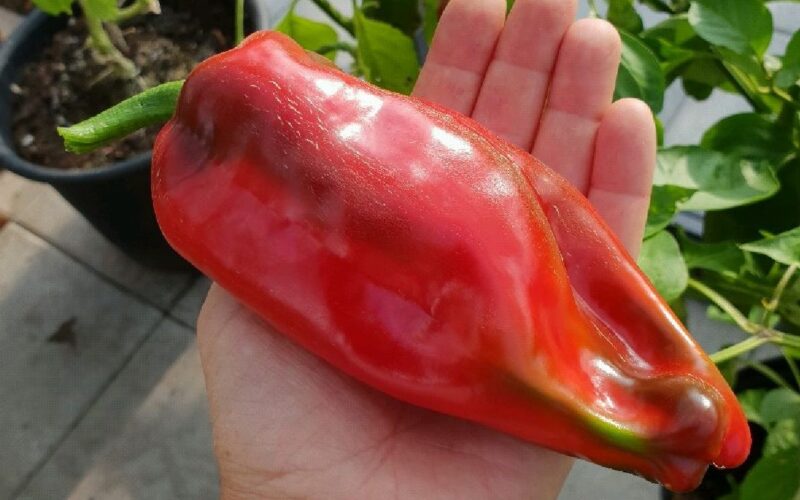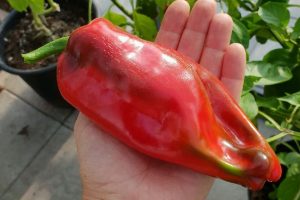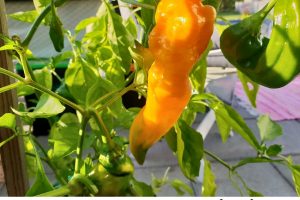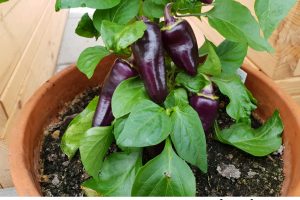Grow your own peppers
Have you tried growing your own chili and achieved success, but find that many chili fruits end up not being very useful? Are you ready for another cultivation challenge? In this post, we share our experiences with growing peppers and offer some tips on great varieties to grow.

How to grow your own Peppers
Spicing It Up: The Hottest Trend in Growing Your Own Food
Growing chili is one of the “hottest” trends when it comes to growing own food. We find the chili enthusiasts everywhere: gardening communities, workplaces and next door neighborhoods. And all they talk about Scoville, colors, varieties, and recipes.
Growing your own chilis is fun and easy. The plants thrive in pots, and you can have them on a balcony, greenhouse, windowsill or outdoors – depending on where you live off course!
When you are successful with growing chili, there is a small downside – you get too many spicy fruits. It’s hard to get use for them all and feels like wasted time and effort. So – instead I have started to grow peppers instead. The needs of a pepper and growing circumstances are very similar to chili, but peppers are so much more useful.
Growing sweet peppers
Peppers need 2 1/2 months to mature once started seedlings have been set outdoors. You need to start seeds indoors 8-10 weeks before your last spring frost date and when you have time to plant them outside. Plants that stay too long in a small pot will stop to grow.
Plant the seeds in small pots with moist soil for seeds and cover with some transparent plastic to keep it from not drying out. Place the pot warm, around 20 C or 68 F. I place my pots on a heated floor or mat to help them start growing. Once I see the small seedlings appear, I move them to a cooler place with lots of light. Since daylight conditions in Sweden this time of year is poor, I always need extra artificial light. I place the light source close to the plant and use a timer set on 10-12 hours.
When the plants are big enough to be handled, I transplant them to bigger pots and start to give them small portions of extra fertilizer when I water.
When the outdoor season starts, I hardy the plants to the outside climate by letting the plants be outside for shorter periods of the day, in the shade.
Peppers like it warm, so I have my plants in a greenhouse, but if you live in a warmer climate you can for sure keep them outdoors. It is no problem to keep peppers in pots their whole lifetime, but it is good to keep in mind that the bigger the pots, the bigger the plants you get.
It is also important to remember to water and fertilize regularly.
4 favorite pepper varieties
Generally, you might prefer to grow varieties that yield smaller fruits. In your experience, varieties with smaller fruits tend to ripen faster and provide a larger harvest. They are also easy to pick and eat day by day. Here’s a list of some favorites that you might find rewarding to grow.
1. Mini ‘Hamik’
A small, hardy plant that grows well in a pot. It gives many, mini fruits that ripen quickly, and the plant delivers fruit over a long period of time, so I can harvest during a long period. It has very few seeds, so you can pick and eat the fruits directly. The orange fruits taste nice and sweet.

2. ‘Marconi Rosso’
This is a red-horn pepper, that gives large fruits with very good taste. They are perfect to use in a salad or on a morning sandwich. It also works as an afternoon snack together with a nice spicy dip. It needs quite some time to turn from green to red, but well worth the wait.

3. ‘Zazu’
This is a pretty, yellow pepper, that curls up a little. Maybe it was missing some nutrients… The fruit was tasty but took a very long time to ripen. With its bright colour, it’s perfect to brighten up a salad.

4. ‘Snacking purple’
The variety ‘Snacking purple’ I would define as more pretty than tasty. The plants are very handy in size and the colourful fruits are an amazing contrast in the garden. The plants turned purple early in their development, which led me to believe that they were ready to eat. But the taste was a more bitter, not sweet like the other once above in the list. I tried to wait longer before I picked them, and they got a bit better but still not super tasty. I tried to use them for different purposes – both in salads and in hot pots. If you like the fact that they are less sweet they are a great addition to any salad and the backup plan is to use them when cooking a nice autumn stew.

If you get more sweet peppers than you consume during the season, I propose that you cut them in pieces and place in the freezer. Then you can use them when for cooking during the rest of the year.
More gardning tips from Gardenize
This post is written by Jenny Rydebrink, founder of Gardenize.
Jenny lives on the west coast of Sweden, where the summers are short but the days are long. The winters are dark an windy. In 2018 she built a new, sturdy and storm proof greenhouse. Thanks to this, her interest in growing her own food has accelerated, and she also enlarged the kitchen garden. There she has room for strawberries, onions, garlic, potatoes, rhubarbs and much more.

